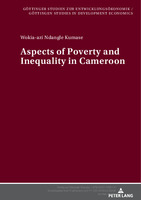Aspects of Poverty and Inequality in Cameroon
Abstract
Poverty and inequality remain extremely high for Cameroon despite improvements in poverty figures between 1996 and 2001. To understand the dynamics of poverty and inequality between 1996 and 2001, this book develops a poverty and inequality profile, investigates the sources of inequality along spatial lines and simulates some policies which could be used in the reduction of poverty and inequality. The book also addresses two major sectors of the Cameroonian economy with a special focus on gender bias in agriculture and linkages between the formal and informal sector. The empirical analyses show that there are large spatial differences in poverty in Cameroon and that sources of inequality vary by location. Regardless of the definition used, the informal sector in Cameroon is extremely large but closely linked to the formal sector. The gender bias experienced by women in access to productive assets in agriculture reduces the efficiency of agricultural production.
Keywords
Aspects; Cameroon; inequality; Inequality; Informal and formal sector linkages; Kumase; Linear expenditure systems; Poverty; PovertyDOI
10.3726/b13873ISBN
9783631753514OCN
1083010927Publisher website
https://www.peterlang.com/Publication date and place
Bern, 2018Series
Goettinger Studien zur Entwicklungsoekonomik / Goettingen Studies in Development Economics, 28Classification
Literary studies: general
Political science and theory
Political structure and processes
Development economics and emerging economies
Economic systems and structures


 Download
Download